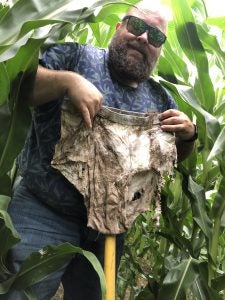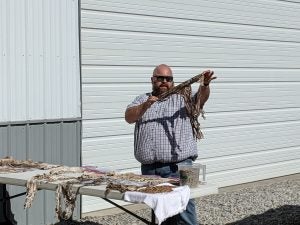In case anyone was wondering, farmers are still out there soiling their undies — all in the name of science and soil conservation through healthy soil practices. This week, The Nature Conservancy’s first “Soil Your Undies” results were released from the Saginaw Watershed Farmer Network Field Day at WMW Bierlein Farms in Michigan.

If you’re not familiar with the #soilyourundies movement on social media, it involved bright white cotton underwear being buried in fields. The fields, all managed differently, represent no-till farming, cover crops, and convention farming strategies. After 40 days, the conservancy unearthed their undergarments to reveal the results of diverse microbial activity in soils — some were mostly intact while others were nearly threadbare down to the waistband.
“The results of our ‘Soil Your Undies’ challenge were abundantly clear: Farmers who implemented healthy soil practices had more biological activity in their soils, which led to a significant breakdown of the underwear,” said Ben Wickerham, agriculture program director for The Nature Conservancy in Michigan. “These healthy soil practices do more than just break down cotton fabrics. They also help protect our drinking water, make fields more resilient to the effects of extreme weather events — like flooding and droughts — and grow high-quality crops.”

During their field day, the Nature Conservancy also featured a rainwater demonstration by Michigan State University Extension. The demonstration illustrated how field management practices impact soil runoff. The Saginaw Bay region is a top agricultural and fishing area in the state, in fact, 20 percent of the state’s agricultural acres are located in the 5.5-million-acre Saginaw Bay watershed. The watershed drains into the Saginaw Bay, providing drinking water to communities and supporting recreational fishing activities. Needless to say, healthy soil practices are not only good for crops, they’re good for the public’s water quality and farmer’s bottom line.
“It makes my stomach turn every time I see topsoil spilling into drainage ditches after a heavy rain, which is why I am working with several other farmers in our area to spread the word about the importance of implementing healthy soil practices,” said Wayne Bierlein, owner of WMW Bierlein Farms. “I would encourage any farmer who is even remotely interested in no-till farming, how to utilize cover crops, and other tried-and-true healthy soil practices to reach out with questions or attend one of our meetings.”
“Our farmer-led peer groups here in Michigan and across the Midwest are vital to spreading the word about healthy soil and water management practices that keep our drinking water safe, make fields more resilient to floods and droughts, and help farmers innovate,” said Mary Fales, soil health and nutrients program director for TNC’s Midwest Division. “The farmers leading these groups are walking the walk and are a great resource for other producers who want to save time and money by implementing these practices.”


